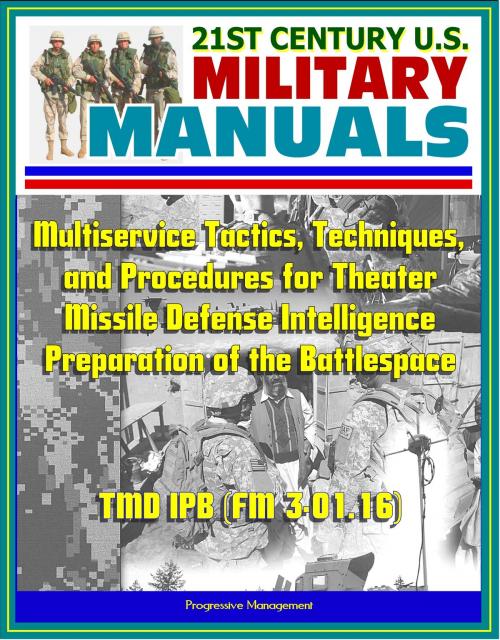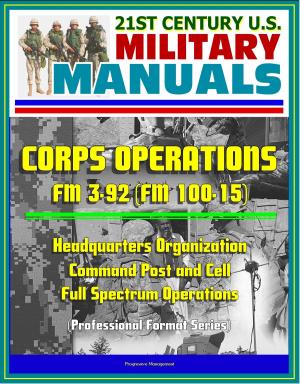21st Century U.S. Military Manuals: Multiservice Tactics, Techniques, and Procedures for Theater Missile Defense Intelligence Preparation of the Battlespace TMD IPB (FM 3-01.16)
Nonfiction, History, Military, United States| Author: | Progressive Management | ISBN: | 9781301927906 |
| Publisher: | Progressive Management | Publication: | November 16, 2012 |
| Imprint: | Smashwords Edition | Language: | English |
| Author: | Progressive Management |
| ISBN: | 9781301927906 |
| Publisher: | Progressive Management |
| Publication: | November 16, 2012 |
| Imprint: | Smashwords Edition |
| Language: | English |
Professionally converted for accurate flowing-text e-book format reproduction, this multiservice publication provides detailed tactics, techniques, and procedures (TTP) for conducting intelligence preparation of the battlespace (IPB). TMD IPB reduces uncertainties regarding terrain, weather, and adversary capabilities to develop potential adversary courses of action. The 4-step IPB methodology detailed in this publication is based on Joint Publication 2-01.3, Joint Tactics, Techniques, and Procedures for Joint Intelligence Preparation of the Battlespace. This publication provides the intelligence analyst the tools to support commander and staff planning and decision making at the joint, combined, and service levels by providing a systematic, continuous, and common methodology for analyzing the adversary theater missile force. The target audience for this publication is the intelligence analyst responsible for IPB development. It will also aid the joint force commander in planning and executing cohesive joint operations against theater missiles throughout the battlespace and be beneficial for sensor employment, collection management, target development, and force application.
CHAPTER I * OVERVIEW * Scope * TMD Mission Areas * TMD IPB Overview * TM Threat Forces * Phases of TMD Operations * Who Conducts IPB * CHAPTER II * STEP-1: DEFINE THE BATTLESPACE ENVIRONMENT * What Is It? * How To Do It For TMD * CHAPTER III * STEP-2: DEFINE THE BATTLESPACE EFFECTS * What Is It? * How To Do It For TMD * CHAPTER IV * STEP-3: EVALUATE THE TM FORCE * What Is It? * How to Create TM Models * Doctrinal Template * CHAPTER V * STEP-4: DETERMINE TM COURSES OF ACTION * What Is It? * How To Do It * APPENDIX A * COMMON TMD IPB PROCESSES * APPENDIX B * SUGGESTED TMD IPB TEMPLATES * APPENDIX C * AUTOMATED TOOLS AND EXAMPLE ARCHITECTURES * APPENDIX D * TMD IPB CHECKLIST AND DEVELOPMENT PLAN. * APPENDIX E * TMD IPB INTERNET LINKS * REFERENCES * GLOSSARY * EXECUTIVE SUMMARY * TMD IPB
As a bonus, this reproduction includes the complete 2012 Army Leadership manual (FM 6-22), which describes the Army's view of leadership, outlines the levels of leadership (direct, organizational, and strategic), and describes the attributes and core leader competencies across all levels. The principal audience for ADRP 6-22 is all leaders, military and civilian. Trainers and educators throughout the Army will also use this publication. Commanders, staffs, and subordinates ensure their decisions and actions comply with applicable United States, international, and, in some cases, host-nation laws and regulations. Commanders at all levels ensure their Soldiers operate in accordance with the law of war and the rules of engagement. It establishes and describes the leader attributes and core leader competencies that facilitate focused feedback, education, training, and development across all leadership levels. An ideal Army leader has strong intellect, physical presence, professional competence, moral character and serves as a role model. An Army leader is able and willing to act decisively, within the intent and purpose of superior leaders and in the best interest of the organization. Army leaders recognize that organizations, built on mutual trust and confidence, successfully accomplish missions.
Professionally converted for accurate flowing-text e-book format reproduction, this multiservice publication provides detailed tactics, techniques, and procedures (TTP) for conducting intelligence preparation of the battlespace (IPB). TMD IPB reduces uncertainties regarding terrain, weather, and adversary capabilities to develop potential adversary courses of action. The 4-step IPB methodology detailed in this publication is based on Joint Publication 2-01.3, Joint Tactics, Techniques, and Procedures for Joint Intelligence Preparation of the Battlespace. This publication provides the intelligence analyst the tools to support commander and staff planning and decision making at the joint, combined, and service levels by providing a systematic, continuous, and common methodology for analyzing the adversary theater missile force. The target audience for this publication is the intelligence analyst responsible for IPB development. It will also aid the joint force commander in planning and executing cohesive joint operations against theater missiles throughout the battlespace and be beneficial for sensor employment, collection management, target development, and force application.
CHAPTER I * OVERVIEW * Scope * TMD Mission Areas * TMD IPB Overview * TM Threat Forces * Phases of TMD Operations * Who Conducts IPB * CHAPTER II * STEP-1: DEFINE THE BATTLESPACE ENVIRONMENT * What Is It? * How To Do It For TMD * CHAPTER III * STEP-2: DEFINE THE BATTLESPACE EFFECTS * What Is It? * How To Do It For TMD * CHAPTER IV * STEP-3: EVALUATE THE TM FORCE * What Is It? * How to Create TM Models * Doctrinal Template * CHAPTER V * STEP-4: DETERMINE TM COURSES OF ACTION * What Is It? * How To Do It * APPENDIX A * COMMON TMD IPB PROCESSES * APPENDIX B * SUGGESTED TMD IPB TEMPLATES * APPENDIX C * AUTOMATED TOOLS AND EXAMPLE ARCHITECTURES * APPENDIX D * TMD IPB CHECKLIST AND DEVELOPMENT PLAN. * APPENDIX E * TMD IPB INTERNET LINKS * REFERENCES * GLOSSARY * EXECUTIVE SUMMARY * TMD IPB
As a bonus, this reproduction includes the complete 2012 Army Leadership manual (FM 6-22), which describes the Army's view of leadership, outlines the levels of leadership (direct, organizational, and strategic), and describes the attributes and core leader competencies across all levels. The principal audience for ADRP 6-22 is all leaders, military and civilian. Trainers and educators throughout the Army will also use this publication. Commanders, staffs, and subordinates ensure their decisions and actions comply with applicable United States, international, and, in some cases, host-nation laws and regulations. Commanders at all levels ensure their Soldiers operate in accordance with the law of war and the rules of engagement. It establishes and describes the leader attributes and core leader competencies that facilitate focused feedback, education, training, and development across all leadership levels. An ideal Army leader has strong intellect, physical presence, professional competence, moral character and serves as a role model. An Army leader is able and willing to act decisively, within the intent and purpose of superior leaders and in the best interest of the organization. Army leaders recognize that organizations, built on mutual trust and confidence, successfully accomplish missions.















